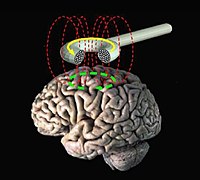
Photo from wikipedia
Objective The retrospective study aimed to explore the difference in mood outcomes and cognitive function between high-frequency repetitive transcranial magnetic stimulation (HF-rTMS) over dorsolateral prefrontal cortex (DLPFC) and electroconvulsive therapy… Click to show full abstract
Objective The retrospective study aimed to explore the difference in mood outcomes and cognitive function between high-frequency repetitive transcranial magnetic stimulation (HF-rTMS) over dorsolateral prefrontal cortex (DLPFC) and electroconvulsive therapy in major depression disorder (MDD) patients and to examine the improvement of HF-rTMS on cognitive impairment evoked by electroconvulsive therapy (ECT). Materials and methods A total of 116 participants with MDD, who completed a 4-week follow-up assessment, were enrolled. The cohort consisted of 26 cases classed as control, 46 participants administrated with HF-rTMS (HF-rTMS group), 22 patients treated with ECT (ECT group), and 23 cases treated with HF-rTMS and ECT at the course of hospitalization (HF-rTMS + ECT group). Medication was kept constant as well in all participants. The 17-item Hamilton Depression Rating Scale for Depression (HAMD-17) and 14-item Hamilton Anxiety Rating Scale (HAMA-14) were used to assess depression and anxiety, respectively. Montreal Cognitive Assessment (MoCA) was to elevate cognitive function. Results No statistical significance was found for baseline in sociodemographic, characteristics of depression, anxiety and cognition, and psychopharmaceutic dosages among control, HF-rTMS, ECT, and HF-rTMS + ECT groups (p > 0.05). Compared with baseline level, total scores of HAMD-17 and HAMA-14 significantly decreased at the end of 4 weeks after treatment (p < 0.001). Furthermore, the decline in scores of HAMD-17 and its sleep disorder and retardation factors from baseline to post-treatment was greater in HF-rTMS, ECT, and HF-rTMS + ECT group than in control (p < 0.05), and there was a significant difference between control and HF-rTMS group in the decline of psychological factor of HAMA-14 (p < 0.01). ECT treatment evoked total score of MoCA to decrease significantly at the end of 4-week after intervention (p < 0.001), and the decline in scores of MoCA and its delayed recall and language performances from baseline to post-treatment was greater in ECT than control, HF-rTMS, and HF-rTMS + ECT (p < 0.05). Conclusion High-frequency repetitive transcranial magnetic stimulation improved psychological anxiety and ameliorated the cognition impairment evoked by ECT though it had the same anti-depressant efficacy as ECT.
Journal Title: Frontiers in Psychiatry
Year Published: 2022
Link to full text (if available)
Share on Social Media: Sign Up to like & get
recommendations!